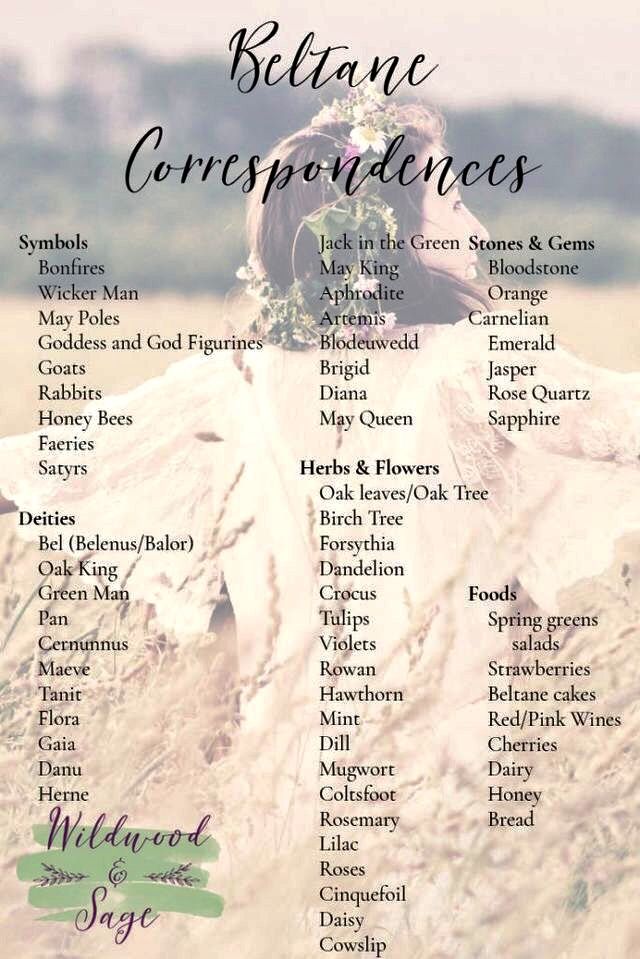
Category: Beltane
Beltane – Spring is Here! Time to Get Your Gardens Ready
Welcome to springtime in the southern hemisphere. As the warmer weather comes a witches thoughts turns to sowing a garden. A garden can mean a different thing to each of us. For me it is getting my physical seeds ready for my veggie garden, to check to see if my herbs survived the winter or if I need to start new ones. Spiritually it means starting new seeds/paths for me to be able to grow to be closer to Mother Earth, the Universal energies, my students, and my teachers. To be able in the fall to reap full benefits of all that I have learned and put them into practice whether it is in my own personal life or helping my students with something. This year I need to plant new seeds and seedlings for all my flower gardens because early heavy rains in this part of the country washed away two inches of top soil in all my flower beds.
What does planting a garden mean to you? Do you plant flowers, vegetables, herbs, goals or a little of all of these or any combination? Remember whatever you plant will come to fruition with the right amount of love, watering (spiritually this can be communicating with each other in the pagan community or even be emailing me to say hi), sunshine (remember to thank the Sun God) and nurturing from within yourself (positive thoughts and affirmations) and from others in our community.
I would really LOVE to SEE COMMENTS on this post, please. Share with us your seeds and lets us help you grow them to their fullest potential!
Copyright 2017 Lady Beltane
Beltane Activities and Correspondences c. 2016
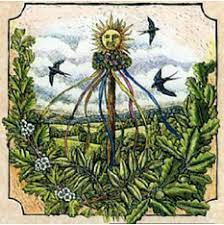
Beltane Activities and Correspondences
Guest Author – Leslie Ravenwing
Herbs – hawthorn, honeysuckle, St John’s wort, wood ruff, all flowers.
Colors- Green, Yellow, Pink, Blue
Foods – Strawberries, Cherries, Fruits, Salads, Wine
Goddesses – Aphrodite, Asherah, Belili, Brigid, Danu, Freya, Flora, Gwenhwyvar, Hina, Ishtar, Maia, Mary, Oiwyn, Oshun, Ostara, Sappha, Tonantzin, Vesta
Gods – Beltene, Cernunnous, Cupid/Eros, Manawyddan and Pan
Activities and Rituals
Fertilize, nurture and boost existing goals, games, activities of pleasure, leaping bonfires, making garlands, May Pole dance, planting seeds, walking one’s property, feasting
Stones/Gems – Emerald, malachite, amber, orange carnelian, sapphire, rose quartz
Other Names – Cetsamhain (opposite Samhain),May Day, Fairy Day,Sacred Thorn Day, Rood Day, Roodmas (the Christian term for Rood Day, Old Beltane, Beltaine, Beltain, Baltane, Walpurgis Night, Floriala (Roman feast of flowers from April 29 to May 1), Walpurgisnacht (Germanic-feast of St. Walpurga), Thrimilce (Anglo-saxon), Bloumaand (Old Dutch)
-Make paper baskets (use yarn as a handle) and place real or silk flowers in each basket. Hang them on door knobs of neighbors and family members but don’t let them know you did it!
-If you have children, make necklaces out of diasies and place them around their necks for the day to bring protection to them.
-Begin planting for the season.
-Create a MayPole and dance around it with your family or friends.
-Make a dish of fruits, berries, nuts and leave in the wood for the animals and fae folk to enjoy
– This is a night for bonfires, torch-lit processions and the high revelry of witches, preferably in high places. It is prime time for the Great Rite, a night (like Samhain) when the Goddess descends into women. Cailleach Beara (Cally Berry, Brighid’s crone aspect) turns to stone this night and does not to return until Samhain. Beltane Eve also marks the setting of the Pleiades
Some of the Witchcraft/Magickal Correspondences and More for Beltane
THREE RITUALS FOR BELTANE
Beltane is a cross-quarter holiday on the Wheel of the Year that honors the return of summer, the return of the fertility of the Earth, and the element of fire. It’s a nature-based holiday that many of our ancestors celebrated for a long time, and now we get to carry that tradition forward.
Like Samhain, Beltane is a time when the veil is thin. This holiday is a particularly beautiful time to connect with nature spirits, as well as any other beings you’re wanting to create a connection with.
At Beltane, we honor the goddess as part of us. We honor the body, pleasure, sensuality, and sexuality. We bask in the fiery energy of the sun and the fertile energy that’s present.
In this blog, I’m sharing three rituals and suggested tools for Beltane that you can work with to honor this sacred holiday. Keep scrolling to watch a video and read more!
OPTIONAL RITUAL TOOLS FOR BELTANE
Feel free to add any of the symbols and tools outlined below to your Beltane rituals or altar. They each correspond with the energy of Beltane. They are not necessary and should be viewed as optional layered energy in your rituals.
Crystals: Rose quartz, garnet, pink tourmaline, rhodochrosite, emerald, malachite, and moonstone
Scents and plants: Sandalwood, ylang-ylang, lilac, angelica, jasmine, and rose
Candle colors: Pink, orange, and red
Element: Fire
Tarot: Empress
Rune: Berakno
Goddess: Venus/Freya
Tools and Symbols: Cowry shell, flowers, and anything that represents pleasure and creativity to you
PLEASURE RITUAL FOR BELTANE…
Click here to read the rest of the rituals from cassieuhl.com

Beltane Correspondences
From paganpages.org
Also known as: Bealtaine, Beltane, Bhealtainn, Bealtinne, Festival of Tana (Strega), Giamonios, Rudemass, and Walburga (Teutonic), Cetsamhain (opposite Samhain),Fairy Day,Sacred Thorn Day, Rood Day, Roodmas (the Christian term for Rood Day, Old Beltane, Beltain, Baltane, Walpurgis Night, Floriala (Roman feast of flowers from April 29 to May 1), Walpurgisnacht (Germanic-feast of St. Walpurga), Thrimilce (Anglo-saxon), Bloumaand (Old Dutch)
Date: May 1
Animals: Swallow, dove, swan, Cats, lynx, leopard
Deities: Flower Goddesses, Divine Couples, Deities of the Hunt, Aphrodite, artemis, Bast, Diana, Faunus, Flora, Maia, Pan, the Horned God, Venus, and all Gods and Goddesses who preside over fertility.
Tools: broom, May Pole, cauldron
Stones/Gems: emerald, malachite, amber, orange carnelian, sapphire, rose quartz
Colors: green, soft pink, blue, yellow, red, brown
Flowers & herbs: almond tree/shrub, ash, broom, cinquefoil, clover, Dittany of Crete, elder, foxglove, frankincense, honeysuckle, rowan, sorrel, hawthorn, ivy, lily of the valley, marigold, meadowsweet, mint, mugwort, thyme, woodruff may be burned; angelica, bluebells, daisy, hawthorn, ivy, lilac, primrose, and rose may be decorations, st. john’s wort, yarrow, basically all flowers.
Incense: frankincense, lilac, rose
Symbols & decorations: maypole, strings of beads or flowers, ribbons, spring flowers, fires, fertility, growing things, ploughs, cauldrons of flowers, butterchurn, baskets, eggs
Food: dairy, bread, cereals, oatmeal cakes, cherries, strawberries, wine, green salads
Activities & rituals: fertilize, nurture and boost existing goals, games, activities of pleasure, leaping bonfires, making garlands, May Pole dance, planting seeds, walking one’s property, feasting
Wiccan mythology: sexual union and/or marriage of the Goddess and God
It’s association with fire also makes Beltaine a holiday of purification.
Wiccan weddings are frequently held on or around Beltaine.

Beltane Foods to Bring to your Fire Festival
From PlentifulEarth.com
A beautiful, spring sun shines overhead on a beautiful Beltane morning, bringing blessings of warmth, love, and passion to every Witch present at the festival of Beltane. A bright fire burns in the distance, marking the celebration between Ostara and the Summer Solstice. The Green Man and Mother Earth each bless handfastings while dozens of Witches happily maypole dance to celebrate the fertility of this beautiful Sabbat.
45 minutes into the Beltane celebration, you think to yourself, “Is it time for the cakes and ale? I’m so ready for the feast! Oh! Hail and welcome!” We’ve literally all been there. Good news; food is a huge part of Wiccan and Pagan celebrations!
In this article, we’ll share the fruits, vegetables, meats, and foods that are best for a Beltane fire festival.
Beltane Recipes and Food Correspondences
Fruits
- Avocado
- Bananas
- Cacao (Chocolate)
- Cherries
- Figs
- Lemons
- Papayas
- Peaches
- Pineapples
- Strawberries
- Vanilla
Vegetables
- Asparagus
- Dandelion (any edible flowers)
- Garlic
- Ginger
- Jalapeno Peppers
- Lettuces
- Mint
- Radishes
- Rhubarb
- Serrano Peppers
- Truffles
Nuts
Herbs & Spices
- Honeysuckle
- Mint
- Nutmeg
- Smoked Paprika
- Thyme
Breads
- Banana Bread
- Bannock Bread
- Oatcakes
Cheeses
- Goat’s Cheese
Meats
- Beef
- Goat
- Rabbit
- Oysters
Drinks
- Ginger Ale
- Honeyed Wine
- Lemonaid
- Mead
- Milk
- Mugwort Tea
- Nettle Tea
- White Grape Juice
Toppings
- Chocolate Sauce
- Curry Sauces
- Honey
- Hot Sauce
- Olive Oil
Flashback 2004 Beltane
Beltane is he holiday that draws all witches outside to celebrate the returning power of the Sun and the fertility of the land.
Wear red robes for ritual and dress your altar with reds for passion. If you have identified a nearby rowan tree, you can make a wreath for your hair using rowan twigs. Decorate your house with freshly cut greens, herbs, and flowers. Arrange for music or drumming to lighten your steps of the dancers of the maypole or spiral dance. Lose yourself in the dance.
Fire is the honored element at this ritual, so have circle members jump a cauldron for purification and protection. Watr is another honored element: be certain to visit your local sacred spring or riverbank. Sprinkle perfume into the water for the undines. Again, leave a drop or two of milk and other food offerings for the nature spirits.
Wake before dawn on this day and watch the Sun rise over a river or beach. Gather a pitcherful where the Sun has gilded the water. When you return home, walk the bounds of your land, sprinkling water in your garden beds to ensure plenty of rainfall during the growing season.
By K. D. Spitzer in Llewellyn’s Witches’ Datebook 2004 Page 63
Beltane Tarot Questions – Printable
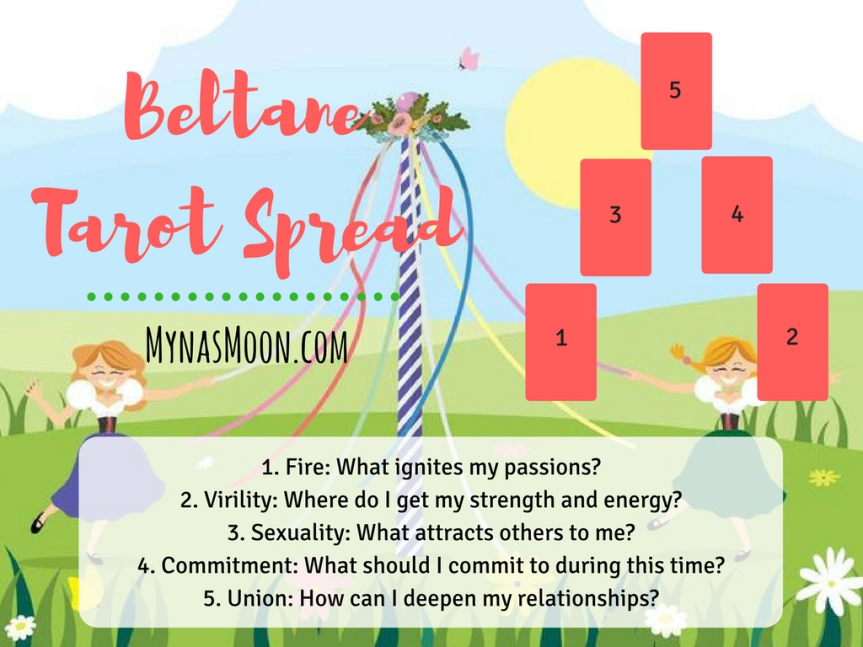
A Very Happy and Blessed Beltane To All

Fertility Deities of Beltane
I feel t is important to remember Lady Abyss as we count down the days until Beltane so I decided to repost an article by her from 2017.
Fertility Deities of Beltane
Beltane is a time of great fertility — for the earth itself, for animals, and of course for people as well. This season has been celebrated by cultures going back thousands of years, in a variety of ways, but nearly all shared the fertility aspect. Typically, this is a Sabbat to celebrate gods of the hunt or of the forest, and goddesses of passion and motherhood, as well as agricultural deities. Here are a list of gods and goddesses that can be honored as part of your tradition’s Beltane rituals.
Artemis (Greek): The moon goddess Artemis was associated with the hunt and was seen as a goddess of forests and hillsides. This pastoral connection made her a part of spring celebrations in later periods.
Bes (Egyptian): Worshiped in later dynasties, Bes was a household protection god, and watched over mothers and young children. He and his wife, Beset, were paired up in rituals to cure problems with infertility.
Bacchus (Roman): Considered the equivalent of Greek god Dionysus, Bacchus was the party god — grapes, wine, and general debauchery were his domain. In March each year, Roman women could attend secret ceremonies called the bacchanalia, and he is associated with sexual free-for-alls and fertility.
Cernunnos (Celtic): Cernunnos is a horned god found in Celtic mythology. He is connected with male animals, particularly the stag in rut, and this has led him to be associated with fertility and vegetation. Depictions of Cernunnos are found in many parts of the British Isles and western Europe. He is often portrayed with a beard and wild, shaggy hair — he is, after all, the lord of the forest.
Flora (Roman): This goddess of spring and flowers had her own festival, Floralia, which was celebrated every year between April 28 to May 3. Romans dressed in bright robes and floral wreaths, and attended theater performances and outdoor shows. Offerings of milk and honey were made to the goddess.
Hera (Greek): This goddess of marriage was the equivalent of the Roman Juno, and took it upon herself to bestow good tidings to new brides. A maiden about to marry could make offerings to Hera, in the hopes that she would bless the marriage with fertility. In her earliest forms, she appears to have been a nature goddess, who presides over wildlife and nurses the young animals which she holds in her arms.
Kokopelli (Hopi): This flute-playing, dancing spring god carries unborn children upon his own back, and then passes them out to fertile women. In the Hopi culture, he is part of rites that relate to marriage and childbearing, as well as the reproductive abilities of animals. Often portrayed with rams and stags, symbolic of his fertility, Kokopelli occasionally is seen with his consort, Kokopelmana.
Pan (Greek): This agricultural god watched over shepherds and their flocks. He was a rustic sort of god, spending lots of time roaming the woods and pastures, hunting and playing music on his flute. Pan is typically portrayed as having the hindquarters and horns of a goat, similar to a faun. Because of his connection to fields and the forest, he is often honored as a spring fertility god.
Priapus (Greek): This fairly minor rural god has one giant claim to fame — his permanently erect and enormous phallus. The son of Aphrodite by Dionysus (or possibly Zeus, depending on the source), Priapus was mostly worshiped in homes rather than in an organized cult. Despite his constant lust, most stories portray him as sexually frustrated, or even impotent. However, in agricultural areas he was still regarded as a god of fertility, and at one point he was considered a protective god, who threatened sexual violence against anyone — male or female — who transgressed the boundaries he guarded.
Sheela-na-Gig (Celtic): Although the Sheela-na-Gig is technically the name applied to the carvings of women with exaggerated vulvae that have been found in Ireland and England, there’s a theory that the carvings are representative of a lost pre-Christian goddess. Typically, the Sheela-na-Gig adorns buildings in areas of Ireland that were part of the Anglo-Norman conquests in the 12th century. She is shown as a homely woman with a giant yoni, which is spread wide to accept the seed of the male. Folkloric evidence indicates that the figures are theory that the figures were part of a fertility rite, similar to “birthing stones”, which were used to bring on conception.
Xochiquetzal (Aztec): This fertility goddess was associated with spring, and represented not only flowers but the fruits of life and abundance. She was also the patron goddess of prostitutes and craftsmen.
by Patti Wigington
Published on ThoughtCo
For Your Viewing Pleasure – Beltane
Edinburgh’s Beltane Fire Festival celebrates the rebirth of summer with fire, dance and drumming c. 2017
Celtic festival of Beltane heats up in Scotland c. 2018
Printable Some Beltane Information
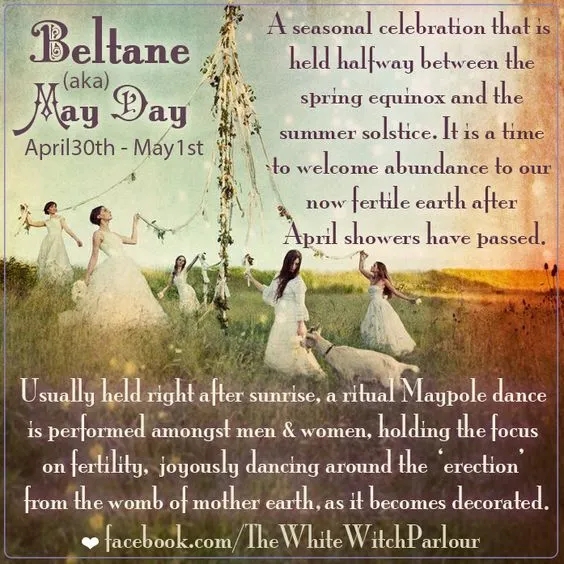
Let’s Have Some Fun – Beltane
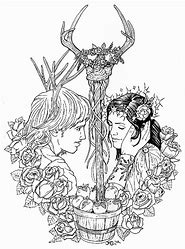
For Your Listening Pleasure – Beltane
Samhain Celebration Guide
To read more about celebrating Samhain please click on this link
From Plentiful Earth – Northern and Southern Hemispheres Samhain
Sweet Beltane
A Version of the History of Beltane
History of Beltane from beltanefire.com.au
The Beltane fire festival welcomes the abundance of the fertile earth and is celebrated with bonfires, Maypoles, burning of the Wickerman, dancing, and a feast, with its roots in European traditions, Beltane is observed by many of today’s Pagans and others as a time for performing rituals
The Celts divided the year into two main seasons. Winter, the beginning of the year fell on November 1 (Irish: Samain) and midyear and summer on May 1 (Irish: Beltaine), opposite for us here in the Southern Hemisphere.
These two junctures were thought to be critical periods when the bonds between the human and supernatural worlds were temporarily erased; on May Eve (southern hemisphere)…
Beltane of the Southern Hemisphere
Today, in the Pagan calendar, the north celebrate the coming of winter at Samhainn. And all the while the sun is peaking up from behind the lush vernal trees and dancing for us once more in the southern hemisphere, as we welcome Beltane on October 31st. Or as I like to refer to it Beltane of the underworld.
A pagan spiral formation in Faerie Glenn where everything is miniature and enchanted. Copyright Content Catnip 2010
Beltane is the Gaelic seasonal festival historically held to mark the midpoint between the spring equinox & summer solstice (Là Bealltainn in Scottish Gaelic; Lá Bealtaine in Irish). Fire is the traditional means of marking this spring festival of optimism & return.
A famous Ossianic lament…
Click here to read more about Southern Hemisphere Beltane from ContentCatnip.com
BELTANE: SOUTHERN HEMISPHERE
Southern Hemisphere Beltane by Jane Hardwicke Collings
The date for the Southern Hemispheric Beltane is October 31st and ‘May Day’ is November 1st. The climax of Spring!
Beltane is the peak of Spring, a celebration of fertility. In ancient times it was the Beltane Rites that recon- nected each year the King to the Goddess, the masculine to the feminine. It is a time for us to give thanks for our fertile lives, our creativity and our gender specific gifts and roles. Its a time to notice and honour the difference in the masculine and feminine. It is a time of increasing growth, building to almost full potential, of beauty and heightened passion.
Beltane Spiritual Practice
Your being, as part of the Earth, part of the cycle of the seasons, will be influenced by this energy whether you’re paying attention to it or not. If you pay some attention, you will feel it, and you can be in flow with it.
Think like the gardener, and align with the Earth energy of now, contemplate the growth that is peaking in your life, that is getting all the attention…
Beltane Printable Coloring Pages
I am not sure how large these will print out. I have found the easiest way to print them is to save them to my computer than print them out individually.
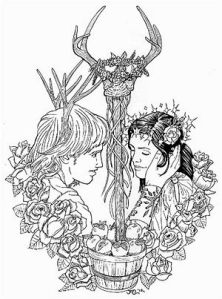
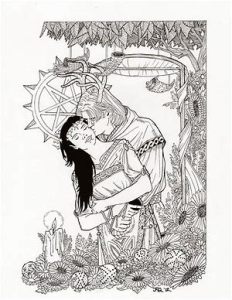
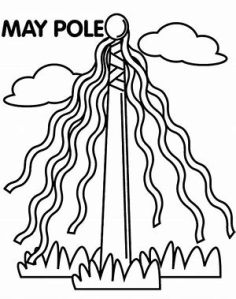
May Day [Beltane] by Jami Shoemaker – Part 1
When I was a little girl, my sister and I would celebrate the first of May by making little paper baskets and filling them with candy. We would then sneak around the neighborhood to our friend’s houses, leave them on the doorsteps, ring the bells, and run away, screaming with laughter. The trick was never to reveal your identity to the recipient of the gift. Little did I know at the time that we were celebrating an old custom that harkened back to ancient times.
Origins
Like any celebration based on ancient agricultural practices, it is impossible to know the exact origin of out May Day. Celebrations of spring are found in cultures all over the world, with similar themes of renewal, planting and growth, the gathering of flowers, and playful celebrations.
However, much of the meaning behind modern Pagan custom can be traced to Celtic origins, or at least with attribute to the Celts. We know that they divided the year into two seasons: summer and winter, the dark and life halves of the year. Within this they honored four major turning points, Samhain, Imbolc, Beltane, and Lughnasadh, with fire festivals.
These festivals coincided astrologically with the Sun at 15 degrees Scorpio, Aquarius, Taurus, and Leo, respectively. This made these pivotal points each a type of “moveable” feast originally, like the solstices and equinoxes, which vary by a day or two from year to year. But due to changes in calendars over time, eventually the first day of the months of November, February, May, and August were earmarked for these festivals, evolving into what Witches call the Great Sabbats, with the celebrations commencing at sunset the eve before.
The flexibility in the actual date is followed by some Pagans today, and May Day, or Beltane, celebrations calculated this way are called “Old Beltane.” This explains the custom in ancient Ireland of celebrating the first day of summer on May 6. This day was given to Inghean Bhuidhe, the Yellow-Haired Girl, one of the three sister-goddesses who brought in the seasons: the First of Spring, the First of Summer, and the First Harvest.
The return of the light was called Cetsamhain (“opposite Samhain”) or Beltaine in Ireland, Galan-Mai in Wales, and in Scotland, Beaultiunn, on the Isle of Man, it was known as Day of Summer and in Germany, Walpurgisnatch. The medieval church renamed the holiday Roodmas, hoping to shift the emphasis from the phallic Maypole to the Holy Rood, or Cross, and celebrations once marked by Pagan frivolity were usurped by festivities held in churchyards.
Copyright Llewellyn’s Witches’ Datebook 2001 Pages21 to25
May Day by Jami Shoemaker – Part 2
Roman Influence
The month of May takes its name from the goddess Maia, who appears in both Greek and Roman mythologies. In Greece, she was “grandmother,” “midwife,” or “wise one” and she was known as the mother of Hermes. The Romans associated her with their fire goddess of the same name who, along with Flora and Feronia, ruled growth and warmth, including sexual desire. Maia’s day was the first of May, and the associations with growth can still be seen in the Christian dedication of the month to Mary, Queen of Flowers.
When Romans came to Britain, they brought with them their own ancient spring rites. The goddess Flora was worshiped as the embodiment of the flowering of all of nature, including human. She was the queen of plants, the goddess of flowers, and the patron of Roman prostitutes. Flora was honored during a week-long festival from April 28–May 3. The Floralia included the gathering of flowers, used in processions, dances, and games. Young raced to see who could be the first to hang a wreath on Flora’s statue, and wrap garlands around the columns of her temple. The female body was especially6 honored at this time. Graphic, erotic medallions were distributed, and public orgies celebrated the fruitfulness of the earth. The “festival of nude women” was celebrates until the third century CE, when Roman authorities demanded the celebrants be clothed. The sense of unrestrained freedom was even enjoyed by Roman slaves on this day, with the stipulation that they return to their mater’s houses that night.
Copyright Llewellyn’s Witches’ Datebook 2001 Pages 21 to 25

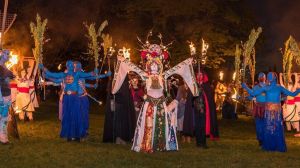

You must be logged in to post a comment.